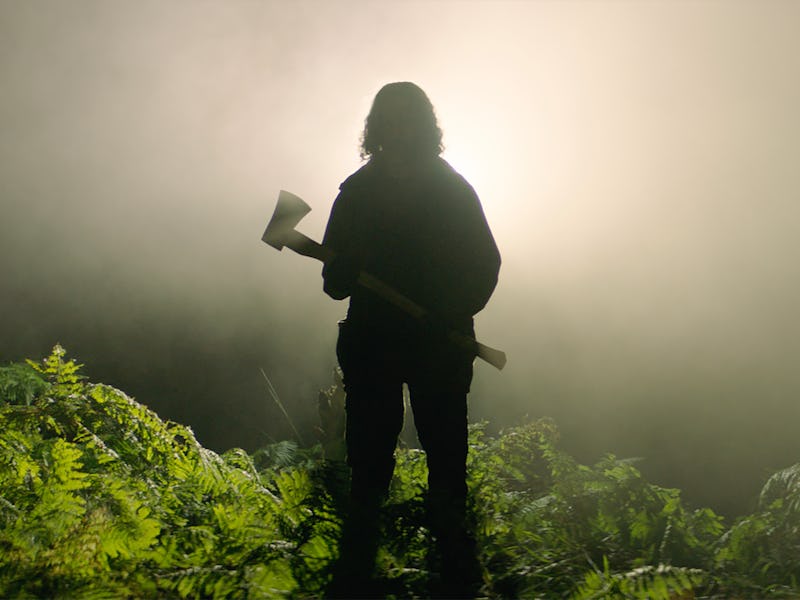In The Earth is the best pandemic sci-fi thriller since 28 Days Later
Believe it or not, this movie will make you afraid to go outside.

Covid-19 has affected every single aspect of our lives. Now, it's starting to sneak into our movies too.
But where movies like Songbird and Locked Down haven't been able to separate themselves from the circumstances around their production — or even justify being set around said circumstances — along comes Ben Wheatley with In the Earth, which avoids the entire issue by setting its eerie modern folk story in the woods far from civilization.
This is a film that uses the suffocating claustrophobia and paranoia of the pandemic to tell a fascinating outdoor ecological nightmare that may even make you (even more) afraid of going outside. It’s also setting a new bar for the inevitable deluge of pandemic-inspired thrillers in our cinematic future.
During an unnamed pandemic, we meet Dr. Martin Lowery (Joel Fry) as he ventures into an isolated research facility deep in the woods to look for Dr. Wendell (Hayley Squires), who is researching the brain-like connection between trees and plants in that forest. Accompanying him is a chain-smoking park ranger named Alma (Ellora Torchia), who's definitely tired of the mysticism people try to tie to this natural setting and simply wants to finish the job and go home.
Like any good forest-set horror movie, bad things happen. Specifically, Alma and Martin are attacked and robbed by unknown assailants. Thankfully, the two are "saved" by a weird hermit named Zach (Reece Shearsmith) who offers them shelter, new shoes, and maybe an impromptu surgery or two, before the film evolves into a sanity-melting psychedelic fever dream full of strobe effects.
Being the first big film festival of the year, Sundance saw a number of pandemic-related premieres, some more effective than others. The best ones, like Eight for Silver (a werewolf movie set during a cholera pandemic) and The Pink Cloud (a sci-fi drama about being stuck indoors for years), feature plots that feel eerily relevant in light of recent events — despite being made in 2019 — but are really just good stories that gain an extra layer of meaning thanks to current events. The worst, like How it Ends (a comedy about the end of the world), simply become time capsules for how filmmaking had to adapt during the pandemic.
Eight for Silver also broaches the topic of pandemics through the lens of an older disease.
In the Earth manages to stand out by being unequivocally about the pandemic. It helps that the film was conceived and shot during the early days of lockdown, but even more important is how Wheatley looks towards the future rather than dwelling on today.
By relying on the director’s early experience making horror movies with minimal resources (In the Earth was shot in 15 days, while Wheatley’s 2014 thriller A Field in England took 12) but infusing it with his emotional response to being forced to stay indoors, In the Earth is that rare Covid movie limited by its budget, rather than the pandemic itself. It’s almost like watching something filmed two years in the future after Hollywood returns to normal and filmmakers can properly process the psychological effects of a long period of isolation.
This is directly reflected in each character’s journey. Everyone in In the Earth is trying to take control of an uncontrollable situation and make sense of an environment that isn't meant to be understood. Wheatley uses classic tropes of horror movies about people lost in the woods, borrowing the psychedelic and eclectic sci-fi aesthetic of films like Annihilation to capture the desperation and paranoia that defined the early days of the pandemic.
There's the eerie sensation that the environment itself is out to harm you, with other characters at the lodge at the edge of the words talking about how those who enter the forest "get a bit funny." And there's the illustration of a local boogeyman-spirit called "Parnag Fegg," a sinister Wicker Man-like figure that looks drawn in crayon by a child, echoing the sinister yet visually pleasant illustrations in Midsommar. Even the scientists talk about the forest trying to communicate, and the sinister sacrifices that must be made to listen.
After a disappointing detour remaking Rebecca for Netflix, Ben Wheatley (right) is back.
Wheatley crams a lot into 107 minutes, but once the film reaches Reece Shearsmith's Zach, it quickly descends into folk horror madness — and ascends into greatness. Shearsmith is clearly having a ball treading the line between ax-murderer and good samaritan, offering to do an impromptu amputation, but really selling that he'd do it to help you. He brings an urgency and also a darkly comedic tonal shift to the movie that makes the concept of plants talking to each other easier to digest.
Despite being made during lockdown with minimal crew and resources, In the Earth still features all of Wheatley's talent for horror, from the sliced, maimed, gory bodies, to psychedelic attacks on the senses with tons of strobe lighting effects, surreal imagery, and phenomenal synth-heavy score. (Composer Clint Mansell even incorporates the sound of plants to create a creepy and unnerving sound that stays with you long after the movie ends.)
After a disappointing detour remaking Rebecca for Netflix, Ben Wheatley digs deep into our collective fear and anxiety during the pandemic to make a folk horror movie about people desperately trying to take back some control over their lives. In the Earth works, not only as the return of one of the great horror filmmakers of the 2010s, but as a reassurance that it’s possible to make a good movie inspired by Covid-19.
In the Earth premiered at the 2021 Sundance Film Festival.